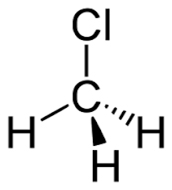 What is Chloromethane?
What is Chloromethane?
Chloromethane is also known as methyl chloride. It is a clear, colorless gas. It has a faint, sweet odor that is noticeable only at levels that may be toxic. It is heavier than air, and it is extremely flammable.
Uses
Methyl chloride is used mainly in the production of silicones where it is used to make methylate silicon. It is also used in the production of agricultural chemicals, methyl cellulose, quaternary amines, and butyl rubber and for miscellaneous uses including tetramethyl lead. Methyl chloride was used widely in refrigerators in the past, but generally this use has been taken over by newer chemicals such as Freon.
Sources & Potential Exposure
Low levels of methyl chloride occur naturally in the environment. Higher levels may occur at chemical plants where it is made or used. Acute (short-term) exposure to high concentrations of methyl chloride in humans has caused severe neurological effects. Methyl chloride has also caused effects on the heart rate, blood pressure, liver, and kidneys in humans. Chronic (long-term) animal studies have shown liver, kidney, spleen, and central nervous system (CNS) effects. Inhalation studies have demonstrated that methyl chloride causes reproductive effects in male rats, with effects such as testicular lesions and decreased sperm production. Human cancer data are limited. Methyl chloride is formed in the oceans by natural processes (e.g., marine phytoplankton) and from biomass burning in grasslands and forested areas (e.g., forest fires); it has been detected at low levels in air all over the world. Other sources of exposure to methyl chloride include cigarette smoke, polystyrene insulation, and aerosol propellants; home burning of wood, coal, or certain plastics; and chlorinated swimming pools. Methyl chloride is also present in some lakes and streams and has been found in drinking water at very low levels. Occupations that present a higher risk of exposure include building contracting, metal industries, transportation, car dealers, and service-station attendants.
Federal Regulations
EPA has classified methyl chloride as a Group D carcinogen (not classifiable as to human carcinogenicity).

 Americas
Americas Europe
Europe Français
Français Deutsch
Deutsch Italiano
Italiano Español
Español



